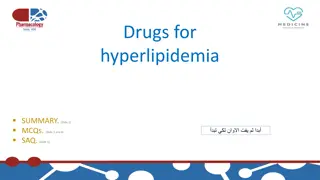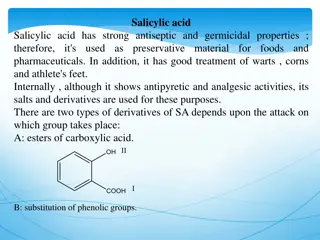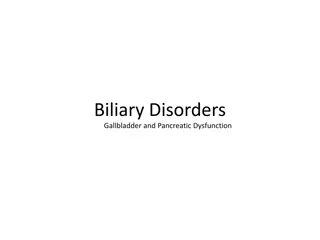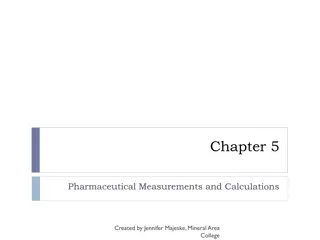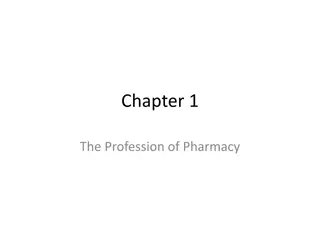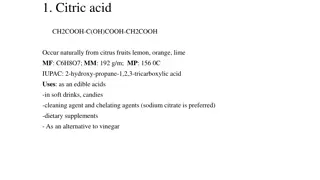Understanding Bile Acid Sequestrants and Fibrates in Clinical Pharmacy
Bile acid sequestrants such as colestipol and cholestyramine act by binding bile acids, promoting hepatic conversion of cholesterol, and increasing LDL-receptor activity to clear LDL-cholesterol. They may interfere with fat-soluble vitamin absorption and have common side effects like constipation and gastrointestinal discomfort. Directions for administration involve mixing the sachet contents with liquid. Dosage recommendations vary for colestipol and cholestyramine in treating hyperlipidemias. Patient counseling and cautionary labels are important considerations.
Download Presentation

Please find below an Image/Link to download the presentation.
The content on the website is provided AS IS for your information and personal use only. It may not be sold, licensed, or shared on other websites without obtaining consent from the author. Download presentation by click this link. If you encounter any issues during the download, it is possible that the publisher has removed the file from their server.
E N D
Presentation Transcript
Bile acid sequestrant and fibrates Assist. Lec. Sura Abbas Clinical pharmacy lab 4 4thstage
Bile acid sequestrants DRUG ACTION Bile acid sequestrants act by binding bile acids, preventing their reabsorption; this promotes hepatic conversion of cholesterol into bile acids; the resultant increased LDL-receptor activity of liver cells increases the clearance of LDL-cholesterol from the plasma. Colestipol and cholestyramine
Caution and side effects caution Interference with the absorption of fat-soluble vitamins (supplements of vitamins A, D, K, and folic acid may be required when treatment is prolonged). Pregnant and breast feeding with caution as although the drugs are not absorbed, they may cause fat-soluble vitamin deficiency on prolonged use. Side effects Common or very common Constipation . Gastrointestinal discomfort . headache . nausea . Vomiting Uncommon Appetite decreased . diarrhea . gastrointestinal disorders CONTRA-INDICATIONS Complete biliary obstruction (not likely to be effective)
DIRECTIONS FOR ADMINISTRATION The contents of each sachet should be mixed with at least 100mL of water or other suitable liquid such as fruit juice or skimmed milk; alternatively it can be mixed with thin soups, cereals, yoghurt, or pulpy fruits ensuring at least 100mL of liquid is provided. PATIENT AND CARER ADVICE Patient counselling on administration is advised for powder (avoid other drugs at same time). CAUTIONARY AND ADVISORY LABELS 13
Colestipol hydrochloride and cholestyramine INDICATIONS AND DOSE (Hyperlipidaemias, particularly type IIa, in patients who have not responded adequately to diet and other appropriate measures BY MOUTH (colestipol) Adult: Initially 5 g 1 2 times a day, increased in steps of 5 g every month if required, total daily dose may be given in 1 2 divided doses; maximum 30 g per day Cholestyramine: Adult: Initially 4 g daily, increased in steps of 4 g every week; increased to 12 24 g daily in 1 4 divided doses, adjusted according to response; maximum 36 g per day
Bezafibrate Adjunct to diet and other appropriate measures in mixed hyperlipidaemia if statin contra-indicated or not tolerated | Adjunct to diet and other appropriate measures in severe hypertriglyceridaemia BY MOUTH USING IMMEDIATE-RELEASE MEDICINES Adult: 200 mg 3 times a day BY MOUTH USING MODIFIED-RELEASE MEDICINES Adult: 400 mg once daily, modified-release dose form is not appropriate in patients with renal impairment
CONTRA-INDICATIONS Gall bladder disease . hypoalbuminaemia . nephrotic syndrome . photosensitivity to fibrates CAUTIONS Correct hypothyroidism before initiating treatment l INTERACTIONS Appendix 1: fibrates
PREGNANCY and breast feeding Manufacturers advise avoid no information available HEPATIC IMPAIRMENT Manufacturer advises avoid in significant impairment (except in fatty liver disease). Renal impairment dose adjustment MONITORING monitoring of liver function and creatine kinase when fibrates used in combination with a statin. REQUIREMENTS Consider
CAUTIONARY AND ADVISORY LABELS 21, 25 Bezalip Mono (Teva UK Ltd) Bezafibrate 400 mg Bezalip Mono 400mg modified-release tablets Fibrazate XL (Sandoz Ltd) Bezafibrate 400 mg Fibrazate XL 400mg tablets\ Tablet CAUTIONARY AND ADVISORY LABELS 21 Bezafibrate (Non-proprietary) Bezafibrate 200 mg Bezafibrate 200mg tablets Bezalip (Teva UK Ltd) Bezafibrate 200 mg Bezalip 200mg tablets
Fenofibrate INDICATIONS AND DOSE Adjunct to diet and other appropriate measures in mixed hyperlipidaemia if statin contra-indicated or not tolerated | Adjunct to diet and other appropriate measures in severe hypertriglyceridaemia | Adjunct to statin in mixed hyperlipidaemia if triglycerides and HDL cholesterol inadequately controlled in patients at high cardiovascular risk
BY MOUTH USING CAPSULES Adult: Initially 200 mg daily, then increased if necessary to 267 mg daily, maximum 200mg daily with concomitant statin, 267mg capsules not appropriate for initial dose titration BY MOUTH USING TABLETS Adult: 160 mg daily DOSE ADJUSTMENTS DUE TO INTERACTIONS Manufacturer advises max. dose 200mg daily with concurrent use of a statin.
CONTRA-INDICATIONS Gall bladder disease . Pancreatitis (unless due to severe hypertriglyceridaemia) . photosensitivity to ketoprofen CAUTIONS Correct hypothyroidism before initiating treatment INTERACTIONS Appendix 1: fibrates
PREGNANCY Avoidembryotoxicity in animal studies. BREAST information available. FEEDING Manufacturers advise avoid no HEPATIC IMPAIRMENT Manufacturer advises avoid no information available. RENAL IMPAIRMENT Manufacturer advises use with caution in mild-to-moderate impairment; avoid if eGFR less than 30 mL/minute/1.73m2.
MONITORING monitor hepatic transaminases every 3 months during the first 12 months of treatment and periodically thereafter discontinue treatment if levels increase to more than3 times the upper limit of normal; monitor serum creatinine levels during the first 3 months of treatment and periodically treatment if creatinine level is 50% above the upper limit of normal. REQUIREMENTS Manufacturer advises thereafter interrupt
Tablet CAUTIONARY AND ADVISORY LABELS 21 Fenofibrate (Non-proprietary) Fenofibrate micronised 160 mg Fenofibrate micronised 160mg tablets | 28 tabletP 6.69 DT = 3.30 Supralip (Mylan) Fenofibrate micronised 160 mg Capsule CAUTIONARY AND ADVISORY LABELS 21 Fenofibrate (Non-proprietary) 67, 200 mg
Gemfibrozil INDICATIONS AND DOSE Adjunct to diet and other appropriate measures in mixed hyperlipidaemia if statin contra-indicated or not tolerated | Adjunct to diet and other appropriate measures in primary hypercholesterolaemia if statin contra-indicated or not tolerated | Adjunct to diet and other appropriate measures in severe hypertriglyceridaemia | Adjunct to diet and other appropriate measures in primary prevention of cardiovascular disease in men with hyperlipidaemias if statin contra-indicated or not tolerated BY MOUTH Adult: 1.2 g daily in 2 divided doses, maintenance 0.9 1.2 g daily
CONTRA-INDICATIONS History of gall-bladder or biliary tract disease including gallstones . photosensitivity to fibrates CAUTIONS Correct hypothyroidism before initiating treatment . elderly INTERACTIONS Appendix 1: fibrates PREGNANCY impairment same as other fibrates and breast feeding, hepatic and renal
MONITORING REQUIREMENTS Monitor blood counts for first year. Monitor liver-function (discontinue treatment if abnormalities persist). Consider monitoring creatine kinase if used in combination with a statin.
Tablet CAUTIONARY AND ADVISORY LABELS 22 Gemfibrozil (Non-proprietary) Gemfibrozil 600 mg tablets Capsule CAUTIONARY AND ADVISORY LABELS 22 Lopid (Pfizer Ltd) Gemfibrozil 300 mg capsules







